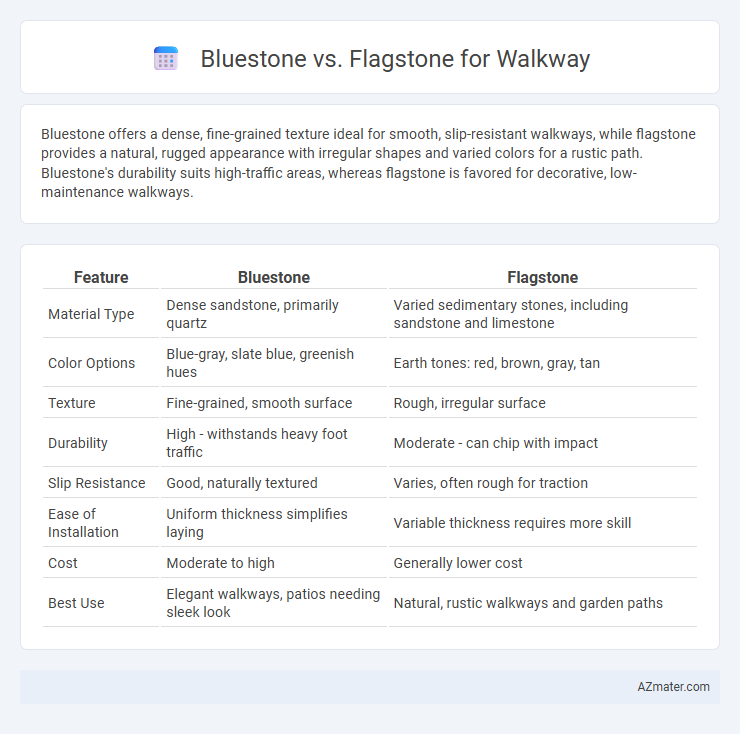Bluestone offers a dense, fine-grained texture ideal for smooth, slip-resistant walkways, while flagstone provides a natural, rugged appearance with irregular shapes and varied colors for a rustic path. Bluestone's durability suits high-traffic areas, whereas flagstone is favored for decorative, low-maintenance walkways.
Table of Comparison
| Feature | Bluestone | Flagstone |
|---|---|---|
| Material Type | Dense sandstone, primarily quartz | Varied sedimentary stones, including sandstone and limestone |
| Color Options | Blue-gray, slate blue, greenish hues | Earth tones: red, brown, gray, tan |
| Texture | Fine-grained, smooth surface | Rough, irregular surface |
| Durability | High - withstands heavy foot traffic | Moderate - can chip with impact |
| Slip Resistance | Good, naturally textured | Varies, often rough for traction |
| Ease of Installation | Uniform thickness simplifies laying | Variable thickness requires more skill |
| Cost | Moderate to high | Generally lower cost |
| Best Use | Elegant walkways, patios needing sleek look | Natural, rustic walkways and garden paths |
Introduction to Bluestone and Flagstone
Bluestone and flagstone are popular natural stones often used in walkways due to their durability and aesthetic appeal. Bluestone is a dense, fine-grained sandstone that offers a smooth surface and comes in shades of blue-gray, making it ideal for modern and traditional designs. Flagstone, typically composed of sandstone, limestone, or slate, features irregular shapes and warmer tones, providing a rustic, natural look in outdoor pathways.
Aesthetic Differences Between Bluestone and Flagstone
Bluestone exhibits a smooth, uniform texture with consistent blue-gray hues, creating a modern and elegant aesthetic for walkways. Flagstone offers a more rustic, natural appearance with irregular shapes and a variety of earthy colors, enhancing a traditional or organic landscape design. The choice between bluestone and flagstone influences the visual tone of a walkway, balancing sleek sophistication against rugged charm.
Durability and Longevity Comparison
Bluestone offers excellent durability with its dense composition, making it resistant to cracking and weathering, which ensures long-lasting performance in walkways. Flagstone is also durable but tends to be softer and more porous, which may lead to faster wear and potential chipping over time, especially in high-traffic areas. Choosing bluestone for walkways promotes greater longevity and requires less maintenance compared to flagstone, making it ideal for long-term use.
Cost Analysis: Bluestone vs Flagstone
Bluestone walkways generally cost between $15 to $30 per square foot, making them a mid-range option in terms of pricing, while flagstone can range from $10 to $35 per square foot depending on the type and quality. Installation costs for both materials vary, with flagstone often requiring more labor-intensive cutting and fitting, potentially increasing overall expenses. Homeowners should consider durability and regional availability as factors influencing long-term value and maintenance costs when choosing between bluestone and flagstone.
Installation Process and Complexity
Bluestone installation involves a precise sub-base preparation and requires dry setting with mortar or a sand base, demanding skilled labor to ensure proper leveling and joint alignment. Flagstone installation offers more flexibility with its natural variation, allowing for loose-lay or mortar-set methods, but irregular shapes increase cutting and fitting complexity. Both materials require attention to drainage and edge restraints, though flagstone's irregularity typically extends installation time compared to the uniformity of bluestone slabs.
Maintenance Requirements for Each Stone
Bluestone requires regular sealing to prevent staining and protect against weathering, with periodic cleaning to avoid moss and algae buildup, especially in damp climates. Flagstone is generally more porous and may demand more frequent sealing and spot treatments to maintain its durability and aesthetic appeal, especially in high-traffic walkways. Both stones benefit from routine sweeping and prompt removal of debris to minimize wear and preserve their natural texture.
Slip Resistance and Safety Features
Bluestone offers superior slip resistance for walkways due to its natural cleft surface texture, providing excellent traction even when wet, making it a safer choice in outdoor environments. Flagstone, while aesthetically versatile, typically has a smoother surface that can become slippery, especially in rainy conditions, requiring additional treatment or textured finishes to enhance safety. Choosing bluestone for walkways prioritizes slip resistance and minimizes the risk of falls, essential for high-traffic or shaded areas prone to moisture.
Weather Resistance and Climate Suitability
Bluestone offers superior weather resistance, making it ideal for regions with frequent freeze-thaw cycles due to its low water absorption and durability in cold climates. Flagstone, often composed of sandstone or limestone, performs well in warmer, drier areas but may be prone to erosion and surface wear in harsh winter conditions. Choosing Bluestone for walkway applications ensures long-term stability and minimal maintenance in variable or wet climates, while Flagstone suits temperate zones with less precipitation.
Eco-Friendliness and Sourcing
Bluestone and flagstone both offer eco-friendly options for walkways, but bluestone is often favored due to its natural abundance and minimal processing requirements, reducing carbon emissions from quarrying and transportation. Flagstone varies widely in composition and sourcing, with some varieties sourced more sustainably depending on regional quarry practices and availability. Choosing locally sourced bluestone or flagstone significantly lowers environmental impact by minimizing transport-related carbon footprint and supporting sustainable quarry management.
Which Stone Is Right for Your Walkway?
Bluestone offers a smooth, consistent texture and cool blue-gray tones that enhance modern walkways, while flagstone provides a rugged, natural appearance with varying shapes and earthy colors ideal for rustic or traditional garden paths. Consider durability and slip resistance; bluestone is dense and less porous, making it more suitable for high-traffic areas and wet climates, whereas flagstone's irregular surface provides natural traction but may require more maintenance. Evaluate the overall landscape style, budget, and climate conditions to determine whether bluestone's refined elegance or flagstone's organic charm best complements your walkway project.

Infographic: Bluestone vs Flagstone for Walkway
 azmater.com
azmater.com